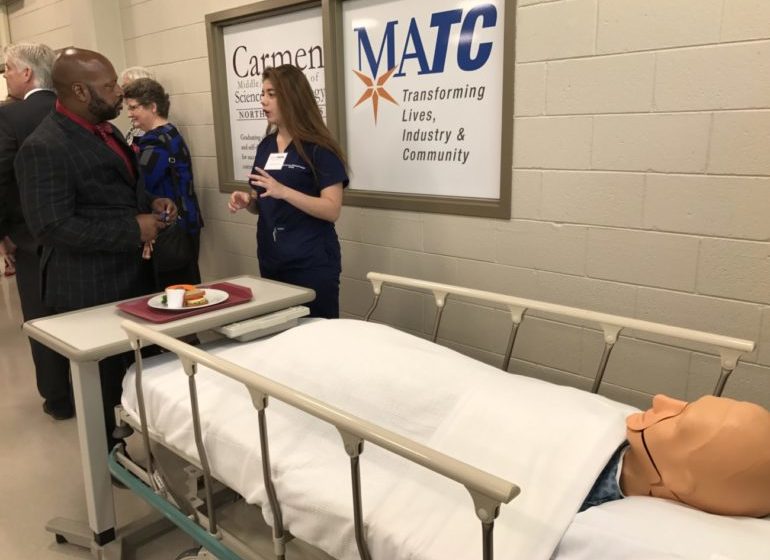While southeastern Wisconsin is seeing an increase in the number of students completing their bachelor’s and higher in health science fields, fewer students are attaining credentials needed for in-demand entry-level health care jobs, a new report says.
Overall, the region has produced a modestly higher number of grads across all health sciences degrees and certificate programs over the past decade, according to the new report from the Wisconsin Policy Forum. But the data shows diverging trends when it comes to higher degree attainment versus shorter-term program completion.
The number of students completing bachelor’s and advanced degrees in health science fields across 18 higher education institutions in the region was up nearly 46% in 2019 compared to 2011, while the number of students completing certificate and associate degree programs in those fields declined by 14%.
The conflicting trends suggest the rise is bachelor’s and advanced degrees represents an “upward shift among students to higher-level programs that require longer time commitments,” WPF said.
For area health systems, the trend compounds on the immediate challenge they face in finding workers. Hospitals and clinics across the region continue to report shortages of nurses, medical assistants and other health care professionals, a trend that is expected to be exacerbated by an aging population that requires more health care and shrinking college enrollment.
According to the report, the region is projected to need 1,567 nursing assistants and licensed practical and vocational nurses each year through 2028 to meet demand for care. Currently, the region’s 18 colleges and universities that make up the Higher Education Regional Alliance have graduated an average of 1,516 students in those fields in recent years.
“Failure to grow the number of graduates likely will perpetuate existing worker shortages,” WPF said.
In 2017, more students completed bachelor’s degrees than certificates in health science fields, which is a striking change from a decade ago, when nearly twice as many health sciences-related certificates were awarded in the region than related bachelor’s degrees, the report said. Certificate completions again outpaced all other program completions in 2018 and 2019, however.
The trend toward higher degree attainment in health fields also stands in contrast to all other disciplines, where completions of bachelor’s and higher degrees have declined significantly over the past decade, the report said.
The report attributes the phenomenon in part to a growing number of new programs offered at area colleges and universities, including pharmacy and related programs, physiology, pathology and public health.
Nurses in the region also appear to be seeking higher degrees, which is consistent with national trends, the report said.
Between 2011 and 2019, the number of students in the region who graduated with a bachelor’s or above in the field of registered nursing, nursing administration, nursing research and clinical nursing increased by 34%, while the number of students earning associate degrees in those areas declined by 29%.
That data reflects an industry-wide push over the past decade to increase the share of nurses with BSN degrees, as hospitals seek to attain “magnet status” (a national credential awarded to health care organizations that meet certain quality standards), the report said.
In the same period, the number of students completing practical nursing, vocational nursing and nursing assistant programs (which are offered at the associate degree and certificate level) declined by 27% in the region.
“The overall result is a slightly increasing number of registered nursing graduates, but fewer graduates preparing for entry-level CNA and LPN positions and fewer nursing graduates overall,” the report said.
The report notes that the low wages offered for CNA positions could be a factor in the lagging program completion rate, but those positions are often a first step toward building a nursing career.
Underrepresentation of men and people of color in health care programs remains a challenge in the region, the report said. Men earned less than one of every five degrees and certifications in health sciences fields in the region between 2011 and 2019. Black students earned 9% of total health science degrees and certificates awarded in the region but accounted for only 3.7% of those at the bachelor’s level and higher during that time.
The report highlights some of the solutions that are currently underway at area colleges, universities and health systems, including:
- Froedtert Health’s partnership with Carmen High School and Cristo Rey Jesuit High School to expose students to health care careers.
- Mount Mary University’s Nursing 1-2-1 program partnership with Milwaukee Area Technical College and Waukesha County Technical College, in which students spend a year at the university, followed by two at a tech college and the final year receiving their BSN from the university.
- WCTC and Gateway Technical College have associate degree programs in nursing designed for paramedics who want to become RNs.
- Marquette University’s direct-entry nursing program that allows those with bachelor’s degrees in other fields to earn a master’s in nursing in two years.
However, both higher ed and industry leaders said there are barriers to expanding programs. On the higher ed side, leaders said there is competition among institutions for limited clinical sites. On the industry side, leaders said associate degree programs in nursing are underutilized and suggested expanding those programs to supply the industry with more RNs who can work while earning their BSN degrees with tuition reimbursement from employers.
And another challenge looms: Overall college enrollment has declined among area higher ed institutions over the past decade, in part due to a decline in high school graduates, and post-Great Recession birth trends have many colleges and universities bracing themselves for a sharp drop in enrollment in 2025.


